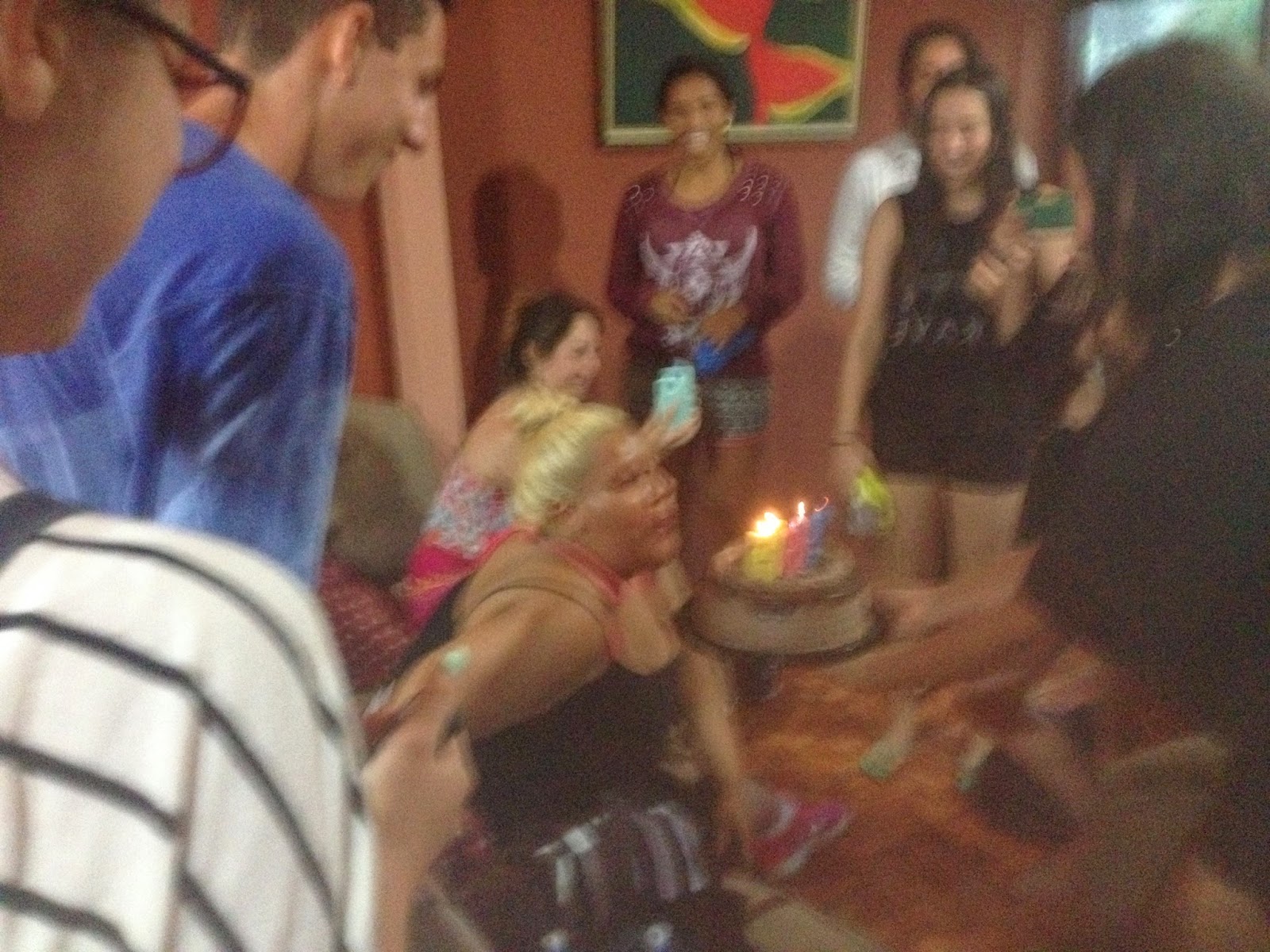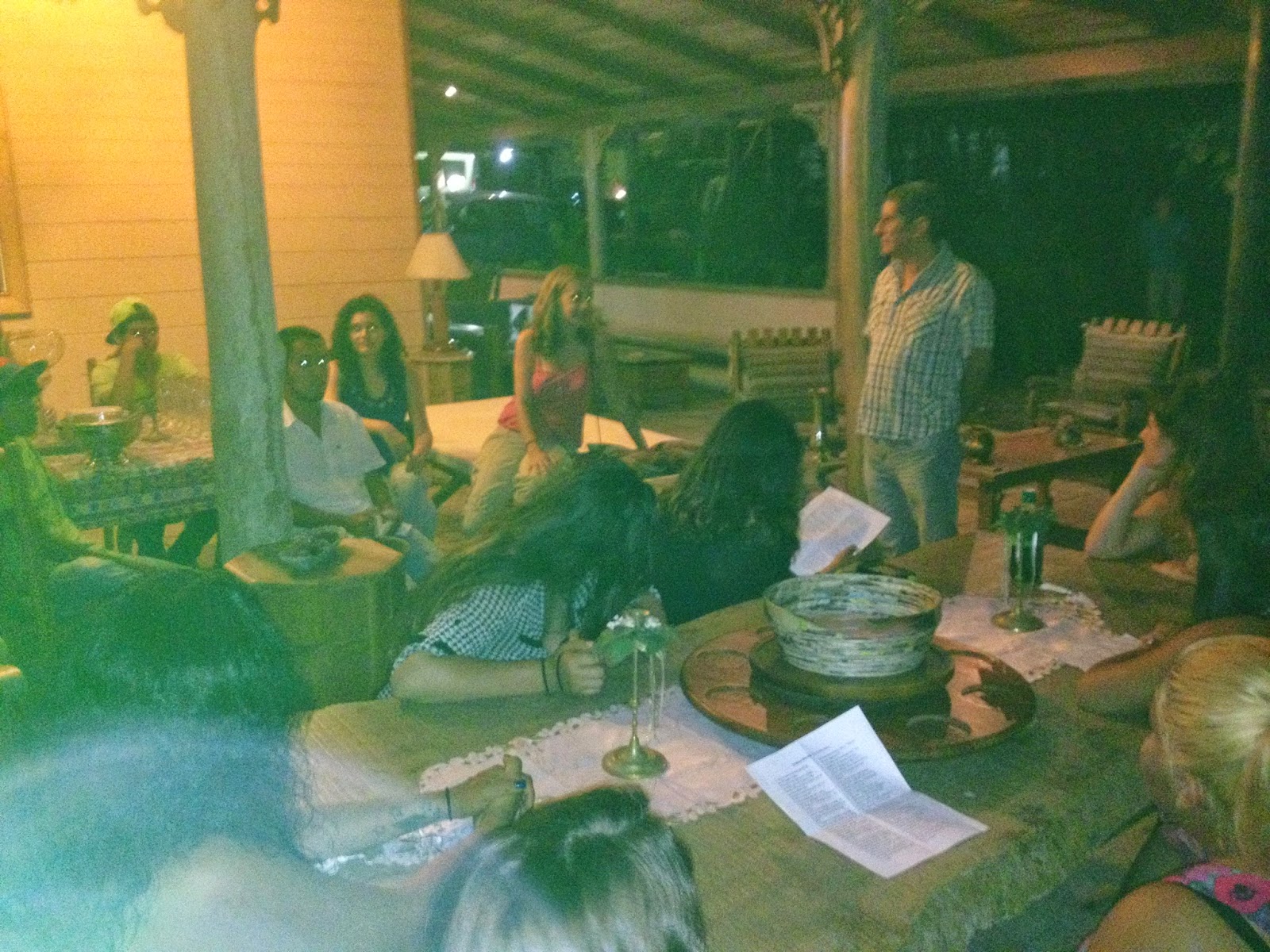Of the two weekend excursions, the second to Rincon de la Viaja is my favorite. First, it’s only a three hour bus ride. Also, the resort where we stay, Buena Vista Lodge, is pretty nice with clean, comfortable rooms. We took off around 1:30 on Friday afternoon. Our first stop was two hours into our drive in Liberia, where the second airport is. We stop at a large plaza with a grocery store where everyone stocks up on supplies.
The resort is in the middle of nowhere, and everything is more expensive there. After we arrive, even though I was assured the rooms were straightened out, there was still confusion. But it gets straightened out. Thankfully they put me and the driver in rooms separate from the group. In fact, the group is isolated from everyone. We meet at the Sunset bar which overlooks a valley with 180 degree views all the way to the Pacific and even to Nicaragua. There are some families there with their kids, about ten of them, around the pool table. We catch a bit of the sunset before it hides behind the clouds.

After we walk to dinner, which is included, which the students appreciate. It is a buffet with salad, spaghetti and meatballs, fish, soup, and homemade bread. Breakfast the next day is also buffet style; they even have an omelet station. After breakfast, the day’s activities begin. First is an hour horseback ride into the rainforest. Z is the only one who is genuinely frightened. My horse is Nina; she’s the lead horse and the others seem to know to keep behind her. The train is a fire road of sorts, rocky, with a lot of hills. We see some iguanas and hear some monkeys but do not see them.

We stop in a valley at the bottom of which is a stream. Along the stream are man-made pools of various temperature water. There are huts to change, and another with lockers, another with restrooms. There is a stone building at the end of one of the pools, a steam/sauna, heated from the thermals of the volcano. There is a slight sulfur smell. At the end of the sauna, there are two cauldrons bubbling with mud. We walk behind the sauna where there are two pestle looking things, about four feet tall filled with the volcanic mud. We slather it on: literally head to toe. We let it dry, then rinse off in the cold mountain water. My skin is baby-ass soft. We are mainly the only ones there, so we have the run of the place. The hottest pool is probably 106 degrees. It cascades into another pool, and then that cascades into yet another, each drop cools the water. We congregate in the middle pool. There are howler monkeys in the trees above. A guava tree drops its fruit in the pools. Vines hang from the 50+ feet tall trees above us. Palms and moss. It is as jungle as it gets.
Maryalice gets a tick, probably from the horse, so we borrow a lighter from one of the guides and Ariana gets tweezers and after some moments, we remove it, head and all. We lounge for a couple of hours here. Another family, a mom and two kids, overhear us about the tick and the mom worries. They are from North Carolina. The boy is a student at the Citadel and talks about studying abroad next year.
To get back to the ranch for lunch, a big John Deere pulling a carriage with ten rows of benches stadium style through the forest. Lunch is in a different place, buffet again. After we zipline. Stephanie is scared, but perseveres. The runs are short, about ten of them. On some they turn the kids upside down or have them fly, superman style. The last one, the guides encourage us to all go upside down.
The next stop is the water slide. I take a pass. It’s fun, but I don’t like the lack of control. A few go more than once. After some go on the hanging bridge tour. I opt to go back to the resort and hit the pool. It is untreated and has a ton of tadpoles. The side are rock looking gunnite. The deep end is painted black; the water is cool and refreshing.
Soon it is happy hour at the sunset bar. We play pool, have a beer. The sun is behind clouds, so there is not much of a view. After dinner, we gather in another room, which has a small bar and a tv. A deck of card appears and I teach them Acey-Deucy or high-low. We play for push-ups or jumping jacks or sips of beer. Even the bus driver joins in.
 The next day I am up early and go to the sunset bar/overlook. A toucan is in a dead tree, but it is too far for a photo. I can tell by the curve of the beak. After breakfast, we take an ecological tour. The resorts aims to be self-sufficient. It opened 25 years ago; prior to that it was a cattle and dairy farm. It grows some of its own food, and has a pig sty. It captures some of its methane gas, and has a worm farm. It also makes its own soap. It was a nice tour.
The next day I am up early and go to the sunset bar/overlook. A toucan is in a dead tree, but it is too far for a photo. I can tell by the curve of the beak. After breakfast, we take an ecological tour. The resorts aims to be self-sufficient. It opened 25 years ago; prior to that it was a cattle and dairy farm. It grows some of its own food, and has a pig sty. It captures some of its methane gas, and has a worm farm. It also makes its own soap. It was a nice tour.
The ride back to Samara is uneventful. Once in town, Alex organizes a volleyball game. When I get back to my apartment, my landlords are having a small party. They invite me up for a cuba libre, as they just returned from Cuba with some rum. Wolfgang has friend in town, Klaus, who speaks German and a little English. Paula, who used to work at the school and her husband from Spain speak Spanish and English. I am tired from the weekend’s activities, and the conversation is hard to follow. The previous week I had mentioned to Paula that I wanted to fish, and her husband arranges for us to go out on Tuesday with Klaus. After one drink, I excuse myself.
I meet the group and play some volleyball. The games are fun. The sun is setting, the water is warm. It’s a nice way to finish the weekend.





















































